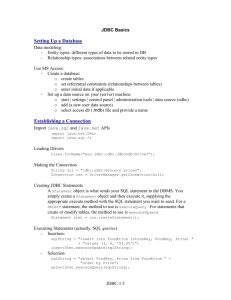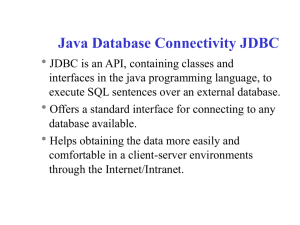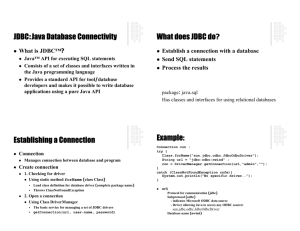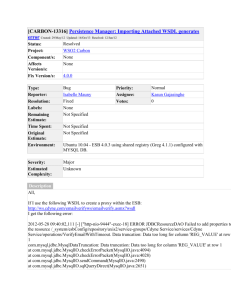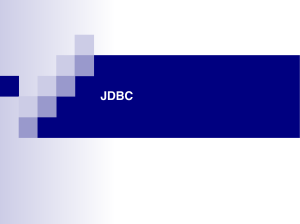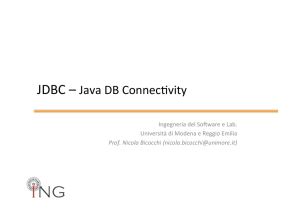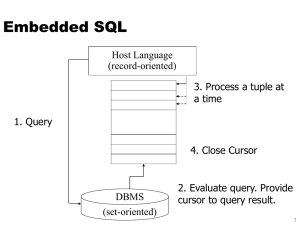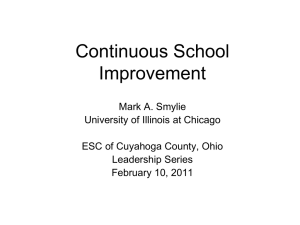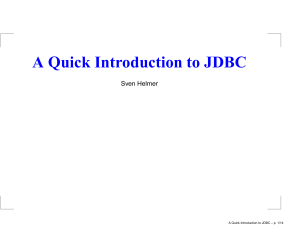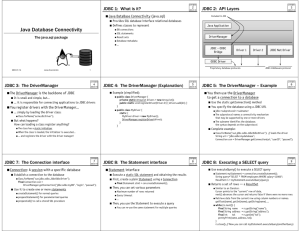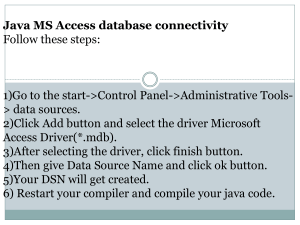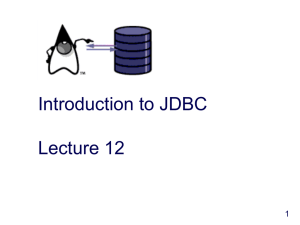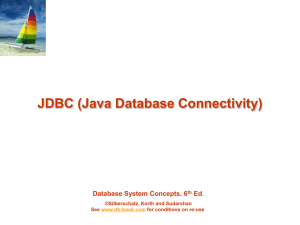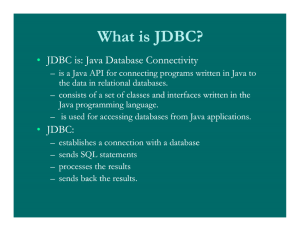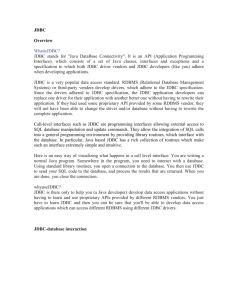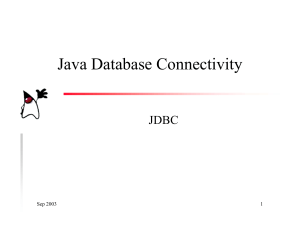JDBC
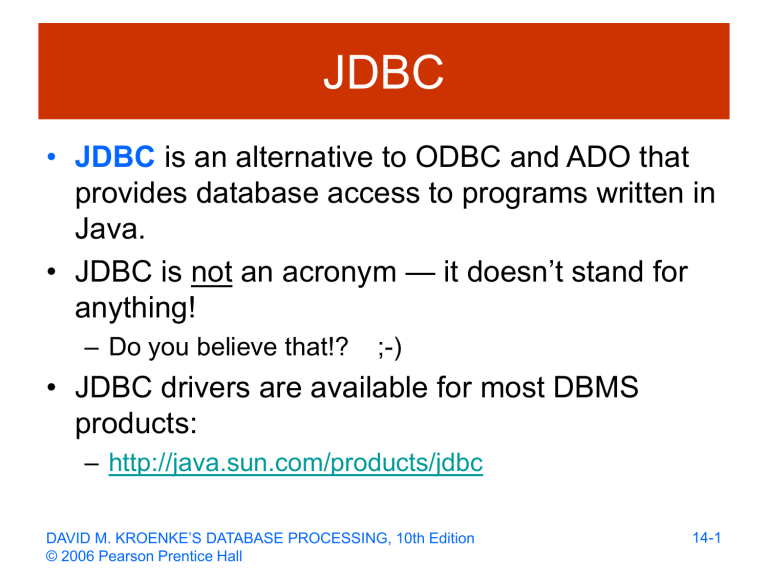
JDBC
• JDBC is an alternative to ODBC and ADO that provides database access to programs written in
Java.
• JDBC is not an acronym — it doesn’t stand for anything!
– Do you believe that!? ;-)
• JDBC drivers are available for most DBMS products:
– http://java.sun.com/products/jdbc
DAVID M. KROENKE’S DATABASE PROCESSING, 10th Edition
© 2006 Pearson Prentice Hall
14-1
JDBC Driver Types
DAVID M. KROENKE’S DATABASE PROCESSING, 10th Edition
© 2006 Pearson Prentice Hall
14-2
Java Servlets and Applets
• Java programs are complied into an operating system independent bytecode .
• Various operating systems use their own bytecode interpreters aka
Java virtual machines .
• An applet is transmitted to a browser via HTTP and is invoked on the client workstation using the HTTP protocol.
• A servlet is a Java program that is invoked on the server to respond to HTTP requests.
• Type 3 and Type 4 drivers can be used for both applets and servlets.
• Type 2 drivers can be used only in servlets.
DAVID M. KROENKE’S DATABASE PROCESSING, 10th Edition
© 2006 Pearson Prentice Hall
14-3
JDBC Components
DAVID M. KROENKE’S DATABASE PROCESSING, 10th Edition
© 2006 Pearson Prentice Hall
14-4
Database Programming Steps
1. Establish a connection
2. Begin transaction
3. Create a statement object
4. Associate SQL with the statement object
5. Provide values for statement parameters
6. Execute the statement object
7. Process the results
8. End transaction
9. Release resources
Using JDBC
1a. Load the driver:
– The driver class libraries need to be in the CLASSPATH for the
Java compiler and for the Java virtual machine.
– The most reliable way to load the driver into the program is:
Class.forName(string).newInstance();
1b. Establish a connection to the database:
– A connection URL string includes the literal jdbc:, followed by the name of the driver and a URL to the database
String url =
"jdbc:oracle:thin:@reddwarf.cs.rit.edu:1521:csodb"; jdbc “subprotocol”“subname” host port database
– Create a Connection object:
Connection con = DriverManager.getConnection(url, dbUser, dbPassword);
Using JDBC (Continued)
2. Begin the transaction con.setTransactionIsolation( Connection.TRANSACTION_SERIALIZABLE ); con.setAutoCommit( false );
3. Create a statement object
Statement stmt = conn.createStatement();
4. Associate SQL with the statement object
String queryString = "create table students "
+ "(name varchar(30), id int, phone char(9))";
6. Process the statement:
Example statements:
ResultSet rs = stmt.executeQuery(querystring); int result = stmt.executeUpdate(updatestring);
ResultSetMetaData rsMeta = rs.getMetaData();
• Compiled queries can be processed via a PreparedStatement object
• Stored procedures can be processed via a CallableStatement object
Using JDBC (Continued)
8. End transaction
con.commit(); con.rollback();
9. Release resources
con.close();
Using a PreparedStatement
// Once you have a connection, you can create a
// "prepared statement" object. A prepared statement is
// precompiled, and can be used repeatedly with new values
// for its parameters.
// Use question marks for parameter place-holders.
PreparedStatement prepStmt = con.prepareStatement(
"INSERT INTO Artist (ArtistID, Name, "
+ "Nationality, BirthDate, DeceasedDate)"
+ "VALUES (ArtistSeq.nextVal, ?, ?, ?, ? )" );
// Now supply values for the parameters
// Parameters are referenced in order starting with 1.
prepStmt.setString( 1, "Galvan" ); prepStmt.setString( 2, "French" ); prepStmt.setInt ( 3, 1910 ); prepStmt.setNull ( 4, Types.INTEGER );
// The PreparedStatement object methods:
// 1) executeUpdate -- statements that modify the database
// 2) executeQuery -- SELECT statements (reads) prepStmt.executeUpdate();
System.out.println( "Prepared statement executed" );
// Now do it again prepStmt.setString( 1, "Monet" ); prepStmt.setString( 2, "French" ); prepStmt.setInt ( 3, 1840 ); prepStmt.setInt ( 4, 1879 ); prepStmt.executeUpdate();
System.out.println( "Prepared statement executed again" );
14-9
Accessing a stored procedure
// Once you have a connection, you can create a
// "callable statement" object to access the stored procedure.
// Inside the curly braces, you call the procedure, and use
// question marks for parameter place-holders.
CallableStatement callStmt = con.prepareCall(
"{call Record_sale( ?, ?, ?, ?, ?, ?)}" );
// Now supply values for the parameters
// Parameters are referenced in order starting with 1.
callStmt.setString( 1, "Barry Goldwater" ); callStmt.setString( 2, "Tobey" ); callStmt.setString( 3, "Mystic Fabric" ); callStmt.setString( 4, "105/135" ); callStmt.setInt ( 5, 24000 );
// And register the OUT variable
// This variable returns information to this program
// from the stored procedure.
callStmt.registerOutParameter( 6, java.sql.Types.VARCHAR );
System.out.println( "Parameters set for CallableStatement" );
// The CallableStatement object has an additional method*
// for use when the stored procedure uses multiple SQL statements.
// 1) executeUpdate -- statements that modify the database
// 2) executeQuery -- SELECT statements (reads)
// *3) execute -- procedures with multiple SQL statements callStmt.execute();
System.out.println( "Stored procedure executed" );
// Get the OUT variable contents (parameter 6)
String result = callStmt.getString( 6 );
14-10
Using ADO.NET
1.
Establish a connection to the database:
String connection_string =
" Server=(local);UID=sa;PWD=;DATABASE=pubs;Connection Timeout=60 " ;
{Odbc|OleDb|SQL}Connection con = new {Odbc|OleDb|SQL}Connection( connection_string );
Con.Open();
2. Begin the transaction
{Odbc|OleDb|SQL}Transaction trans = con.BeginTransaction(
[IsolationLevel.{Chaos|ReadCommitted|ReadUncommitted|
RepeatableRead|Serializable|Unspecified}] );
3. Create a statement (Command) object
{Odbc|OleDb|SQL}Command statement = con.CreateCommand(); statement.Transaction = trans;
Using ADO.NET (cont.)
4. Associate SQL with the statement (Command) object statement.CommandText = “INSERT INTO authors …
6. Process the statement int rowsInserted = statement.ExecuteNonQuery();
Also: statement.ExecuteReader() returns a DataReader statement.ExecuteScalar() returns a single value
8. End transaction trans.Commit(); trans.Rollback();
9. Release resources conn.Close();
